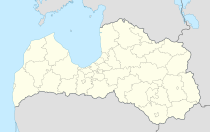Zilupe
| Zilupe ( German : Rosenau) | ||
|---|---|---|
 |
|
|
| Basic data | ||
| State : |
|
|
| Landscape: | Latgale ( Latvian : Latgale ) | |
| Administrative district : | Zilupe district | |
| Coordinates : | 56 ° 24 ' N , 28 ° 7' E | |
| Residents : | 1,634 (Jan 1, 2016) | |
| Area : | 5 km² | |
| Population density : | 327 inhabitants per km² | |
| Height : | ||
| City law: | since 1231 | |
| Website: | www.zilupe.lv | |
| Post Code: | ||
| ISO code: | ||
Zilupe (German: Rosenau ; Russian Розеново , Rosenowo ) is a city in eastern Latvia on the Russian border. In 2016 it had 1634 inhabitants.
history
The German place name comes from the Rosen family who owned land here. With the start of rail traffic on the Krustpils - Moscow route , the Rosenovskaya (Розеновская) station was opened in 1901. On the left bank of the Zilupe a settlement of railway workers, unskilled workers and traders soon arose. In 1908 there was already a village mayor as well as a police station, school and post office.
The First World War interrupted further development. The railway bridge was blown up when the German army marched in. After the end of the war, Bolshevik troops marched into Latvia. In January 1920, an offensive by the allied Latvian and Polish forces ended Soviet rule in Zilupe. The troops deployed there stopped at the river Zilupe (Russian: Сінюха), which was to form the new border in the still secret peace negotiations ( Peace of Riga 1920 ).
A new upswing began as part of the independent Latvia. Until 1924 there was a transhipment point at the border crossing where precious metals were exchanged for deliveries of goods (e.g. food). The metals (mostly gold and silver) were then transported from Zilupe to Riga. In 1931 Zilupe received town charter. The inhabitants lived mainly from trade, agriculture and handicrafts. But there was also a stock corporation that operated water mills with electric generators and a sawmill.
The Red Army marched in in June 1940 and the Wehrmacht in July 1941 . On July 17, 1944, Zilupe became Soviet again. The residents of Zilupe also suffered from arrests and deportations.
From 1949 to 1959 Zilupe was the district town . The largest employers up to 1990 were a metalworking factory (e.g. children's sledges), a sewing shop and a bread factory.
The city is home to the border crossing of the railway line and the European route 22 , which is represented in Latvia by the A12 and in Russia as the M9 . Both routes connect the capitals Moscow and Riga of the border states.
literature
- Astrīda Iltnere (ed.): Latvijas Pagasti, Enciklopēdija. Preses Nams, Riga 2002, ISBN 9984-00-436-8 .
Web links
- Partnership Bad Bodenteich and Zilupe (German, Lat.)
- Reģionālās attīstības un pašvaldību lietu ministrija ( Memento of February 7, 2014 in the Internet Archive ) ( MS Word ; 1.2 MB)
- Latvijas iedzīvotāju skaits pašvaldībās July 1, 2010
Individual evidence
- ↑ Latvijas iedzīvotāju skaits pašvaldībās pagastu dalījumā (Latvia's population by municipality) on the website of the Office of Citizenship and Migration Affairs at the Ministry of Interior of Latvia


